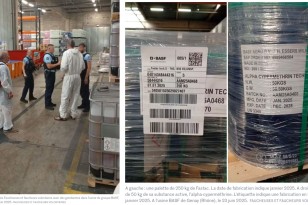Une réunion importante des Etats membres de l’UE sur le sujet des abeilles a acté hier le fait qu’il serait désormais toléré, au sein de l’UE, une perte maximum de 10% des colonies d’abeille* après une seule exposition à un pesticide pulvérisé dans un champ, suivant le « scénario pire cas ».
Les hic – et ce ne sont pas des moindres – c’est que cet accord ne prend pas en compte:
1. Les expositions à des cocktails de substances,
2. Les expositions répétées dans le temps,
3. Le manque de sensibilité des tests (chez les humains par exemple, il y a un facteur 10 pour la sensibilité intra-espèce).
Certes politiquement parlant, les dégâts sont limités et il est possible de dire que nos ONG ont fait un bon travail car des Etats membres poussaient pour aller au delà des 10% comme de nombreux pays de l’Est et même jusque jusque 23% de pertes pour la Grèce, la Hongrie, l’Espagne et la Belgique. Ces 3 derniers pays ont finalement calé leur position entre 7 et 10%, seule la Grèce a maintenu sa demande à 23%. Les autres pays ayant changé leur position grâce à l’action des ONG. La France était elle sur 7 % et a voté malgré tout pour le « compromis » à 10% de pertes.
D’un point de vue environnemental, ce n’est bien sûr pas acceptable pour nos ONG. D’un côté parce que comme le souligne justement l’un de nos collègues européens de PAN Europe « un éleveur de porcs n’accepterait pas que ses porcelets perdent 10% de leur poids du jour au lendemain ». De l’autre, parce que cette décision ouvre la voie à une protection insuffisante des pollinisateurs sauvages (ce sera le prochain point de négociations).
Donc des efforts peut-être mais bien loin d’être suffisants…
* Ci-dessous les positions des Etats membres
During the AGRIFISH council meeting on 28 June, a vast majority of Member States have backed the proposal from the European Commission to set the acceptable level of pesticide harm to honey bee colonies at 10% mortality. While politicians claim the 10% agreement is a political success[1], PAN Europe believes this agreement will continue to damage European pollinators and insects in general. This is in opposition with the Biodiversity Strategy from the European Green Deal.
Following the scandal around the intoxication of thousands of beehives across the EU with neonicotinoid insecticides, the European Food Safety Authority (EFSA) had proposed in 2013 a new methodology[2] to improve the risk assessment on the toxicity of pesticides on bees. At the time, experts from Member States agreed on a maximum 7% reduction in honey bee colony size due to pesticides. The so-called Bee Guidance Document was never approved by EU agricultural ministers because they feared the approach would remove too many pesticides from the market. AGRIFISH Council decision therefore puts an end to the 8-year saga where Member States kept refusing to move forward with improving the risk assessment on the toxicity of pesticides on bees. The previous risk assessment was nearly 20 years old and was partly co-written by the pesticides industry itself.
Martin Dermine, health and environmental policy officer at PAN Europe said: “We are highly concerned because allowing for 10% reduction in honey bee colony size means we accept an important impact of the use of pesticides on insects. This will maintain on the market pesticides that are the main driver of the decline of pollinators in Europe”.
In 2013, following a scientific approach, the European Food Safety Authority (EFSA) had reached to the conclusion that after one exposure to a single pesticide, a honey bee colony could survive to a 7% reduction in colony size2.
Martin Dermine to add: “The approach is biased: Member States and the European Commission base their decision on a single exposure scenario while in real life, our pollinators are exposed to cocktails of pesticides and other toxic chemicals on a daily basis. Evidence also shows that pesticides increase bees’ susceptibility to pathogens. This is not considered at all”.
PAN Europe had asked for a maximum of 5% “acceptable reduction” to take into account the lack of protection linked to the numerous shortcomings of risk assessment.
Martin Dermine to conclude: “The European Commission and Member States are here creating a situation of unequal treatment: while a beekeeper will be obliged to accept that another farmer kills up to 10% of his bees by using pesticides, what would a pig producer say if his piglets lost 10% of their weight from one day to another every week?”.
The European Commission has committed to start restoring biodiversity in Europe by 2030 in the frame of the Biodiversity Strategy of the Green Deal. PAN Europe, jointly with ca. 200 organisations in Europe is advocating for a bee-friendly and pesticide-free agriculture in the frame of the Save Bees and Farmers[3] European Citizens initiative that has collected over 600 000 signatures throughout the EU.
[1]https://ec.europa.eu/commission/presscorner/detail/en/statement_21_3302
[2]https://www.efsa.europa.eu/en/efsajournal/pub/3295
It would be great if you could circulate it in your network. If you want to share on social media, here is the link: https://www.pan-europe.info/press-releases/2021/06/european-countries-%E2%80%9Cimprove%E2%80%9D-bees%E2%80%99-protection-against-pesticides-allowing




 a besoin de toutes les forces vives pour poursuivre son action
a besoin de toutes les forces vives pour poursuivre son action
